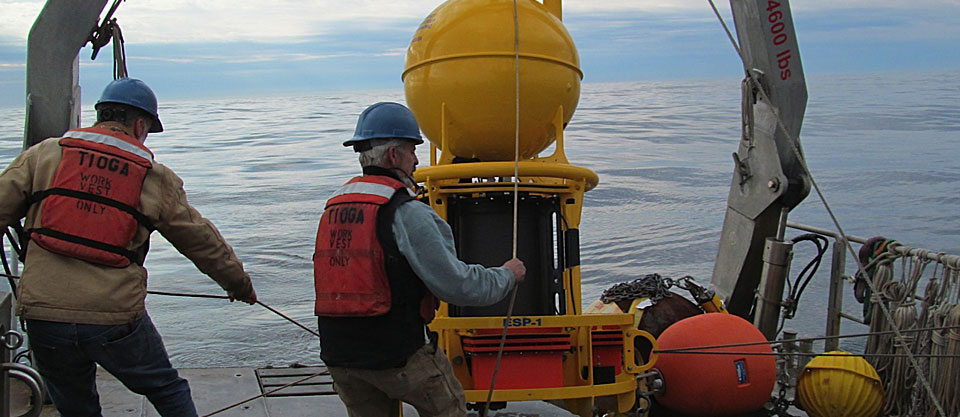Moderate Harmful Algal Bloom Season Predicted for Gulf of Maine
New tech promises improved offshore observations and better early warning forecasts.

Coastal Intelligence
Better harmful algal bloom forecasts provide government and industry with the 'coastal intelligence' needed to decide where, when, and how frequently to monitor shellfisheries helping to minimize economic losses and potential human health impacts. Here, scientists prepare to launch a sensor that will gather data on toxin levels and harmful algal bloom cells in offshore waters. Image credit: Woods Hole Oceanographic Institution
Forecasters predict a moderate red tide in the Gulf of Maine this season. The prediction was made with computer models that use data on cysts, or seeds, of toxic algae Alexandrium fundyense collected last fall with NOAA's research vessel Okeanos Explorer. These models will also be run weekly from April to August to better predict where these harmful algal blooms (HABS) may appear during the Gulf of Maine red tide season.
For the first time, forecasters will benefit from an array of robotic HAB sensors known as Environmental Sample Processors (ESPs). Four ESPs deployed in locations around the Gulf of Maine are providing actual data on the numbers of Alexandrium cells and toxin levels present in offshore waters. Forecasters are also using observing systems data to track ocean conditions such as sea surface temperatures, nutrients, solar radiation, and circulation. Offshore observations improve the accuracy of Gulf of Maine HAB forecasts.
Early warnings of toxic Alexandrium blooms are being distributed to more than 150 coastal resource and fisheries managers via the Northeast Paralytic Shellfish Poisoning website. These warnings provide government and industry officials with information needed to decide where, when, and how frequently to monitor shellfisheries to minimize economic losses and potential human health impacts.
National Center for Coastal Ocean Science sponsorship and scientists are leading this effort to expand operational NOAA HAB forecasting to the Gulf of Maine.
This effort is led by Woods Hole Oceanographic Institution in partnership with NOAA. Additional support is provided by the U.S. Integrated Ocean Observing System (IOOS®) Program, NOAA Office of Coast Survey, NOAA Center for Operational Oceanographic Products and Services, North Carolina State University, University of Maine, and Monterey Bay Aquarium Research Institute.
Get Social
More Information
Did you know?
Delivering more timely and accurate harmful algal bloom forecasts for the Gulf of Maine is part of a larger nationwide NOAA effort called 'ecological forecasting.' An ecological forecast predicts changes in the environment due to drivers such as climate variability, extreme weather conditions, pollution, or habitat change. Learn more
